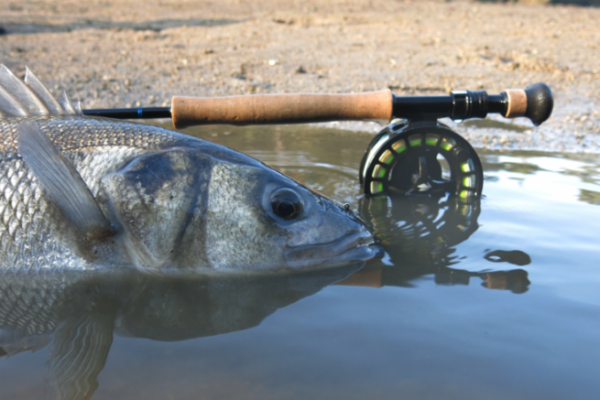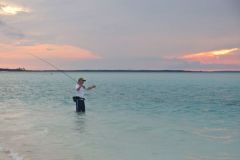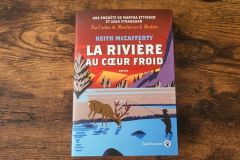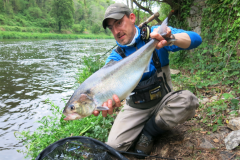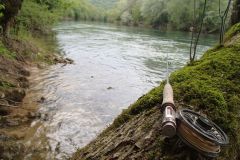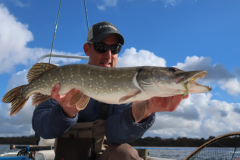What equipment do you need to fish for sea bass from the shore?
Sea bass can be fly-fished with specific tackle, but tank tackle can do the trick if you don't want to invest and try it out for the first time.
You need a 9-foot rod with 8 and/or 9 power depending on conditions, which gives you enough power to cast flies of a certain size far and often into the wind.
The reel won't be of the utmost importance, because even if the bass is a combative predator, it won't pull out several metres of backing and doesn't require a top-of-the-range drag.
Depending on the type of position, the line should be of different densities. It's a good idea to have at least one intermediate line, which is really the most versatile line for searching for sea bass. However, a floating line will enable you to fish in little water, over "structures" such as grass beds, oyster beds, etc... But it can also be used on the surface to bring bass to the surface.
Sometimes, in strong currents or in deep water, a sinking fly line will be appropriate, as it will allow our fly to sink into the water layer, which is sometimes necessary in these situations or in the absence of activity.
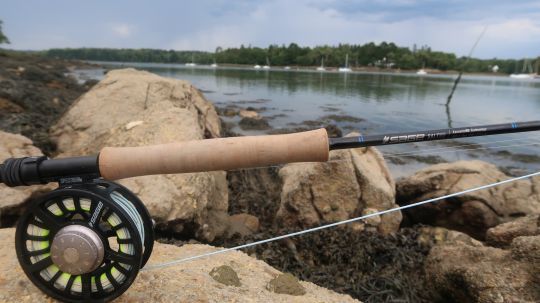
Personally, I use an 8" rod for calm conditions and "fine" or surface fishing with a floating line.
But when you need to cast far or into the wind, a 9" rod is a great asset.
Fitted with an intermediate line, it allows me to fish in more than 70% of the situations that can be encountered for sea bass.
A reel with two spools allows you to quickly change line density and adapt to the position or conditions.
Rods: Sage R8 Salt 9' 8" silk and Sage Maverick 9' 9" silk
Reel: SAGE Spectrum C 7/8 + 100 m backing in 20 or 30 lbs.
Silk: Rio Striper floating and/or intermediate, even plunging
Leaders: Rio striper 7 feet tip in 12 lbs + tip for fine fishing and one rod length leader made of three tapering fluorocarbon strands for intermediate silk fishing.
Tip: DFC fluorocarbon in 8 to 12 lbs (25 to 32°) depending on water color, fish wariness and position (rocks, obstacles, etc.).
A chest pack, or small bag, for storing fly boxes, thread spools, extra silk spools, thread cutters, etc...
A casting basket is essential for sea bass fishing from shore. It allows you to cast further by storing your silk in the basket.
A pair of polarizers for safety reasons and to protect your eyes, but also to spot fish or see following bass.
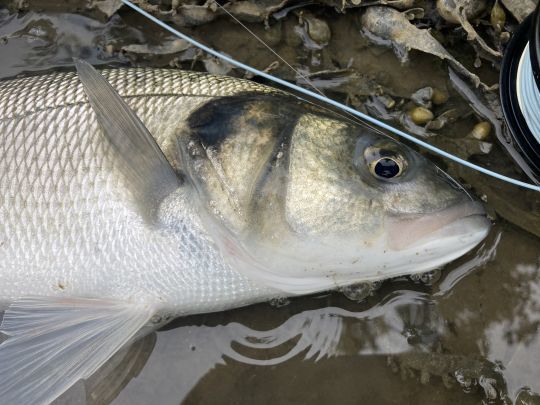
Where can you fly-fish from the shore?
Whether in Brittany, Normandy, the Atlantic seaboard or the Mediterranean, you can find sea bass in a wide range of environments.
In France, we're fortunate to have a wide range of fishing spots to choose from, which means you'll need to adapt your technique and equipment to each one.
- Beach fishing :
The beaches are interesting all year round, as bass come here to feed on sand eels and small fry, gobies.
They're "easy" to fish, as they're not very tiring, and for novice anglers it's an ideal spot.
Finding bars isn't always easy, but with a little experience and regular visits to the same beaches, you'll be able to find the most popular spots.
Sometimes there's sea bass hunting going on, or you can spot activity from the birds. If not, you need to look at how currents form, whether the bottom changes, the presence of structures, etc., to find more interesting areas.
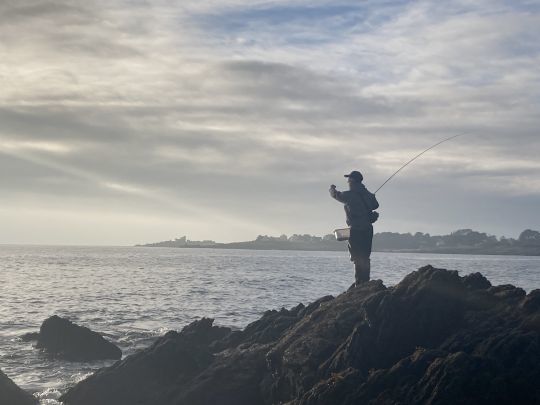
- On the coast :
The coast is also an interesting place for sea bass, who come to seek their prey heckled by the waves on the rocky points in particular, but also the prey that live there such as rock fish, little old ladies, but also crabs and shrimps.
Rocky points are often strategic locations, as they represent places of passage. However, you need to find the right time of the tide to fish them.
These areas are more difficult to fish and should be explored by anglers more at ease than beginners. They are also more "dangerous" to fish, so you'll need to be in good physical condition.
- Estuaries :
Estuaries are very rich environments where juvenile sea bass and large sedentary sea bass share the available food.
It takes a little time to understand the workings of each estuary, but these are great fishing grounds, whether for the novice or the experienced angler.
The tides will once again be of great importance for fishing in the right place at the right time. Water level is the key factor, as it often is.
It is possible to sight-see for sea bass along the edges, but also to prospect with streamers or shrimp imitations, which are often effective in these estuarine sectors.
- Oyster park :
Oyster beds are bass magnets. In fact, they concentrate food and sea bass come here regularly.
It's possible to sight-fish around and between the tables, but also above them with floating silks and surface flies or intermediate silks when the water is higher.
These are very good areas for finding fish without knowing too much about sea bass fishing, but you still need to find the right parks (not all are the same) and the right times and tidal coefficients.
- Ports :
Harbors are also rich areas, where many fish find refuge or come to feed.
Wolffish and sea bass are also on the menu, and can be caught day or night.
At night, street lamps attract small fry, and predators will come to take advantage of this windfall.
- Salt pond :
Tidal ponds and salt ponds are also fishing grounds for sea bass and wolffish, which once again take advantage of these special environments to find their food.
They are not always authorized for fishing, but by asking the owners or asking around, it is possible to fish there.
Sea bass and wolffish also move in with the tides, and we need to find the right areas where they feed or where they pass through.
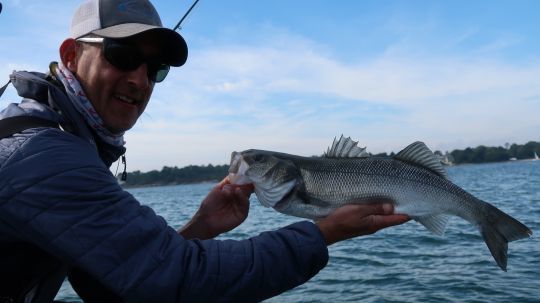
A selection of flies for different approaches
The flies will have to imitate the prey that interests our bass and wolves.
So you need to know what food and prey are present on each of the fishing spots where you'll be fishing for this superb predator.
The sea bass angler will therefore have in his possession various types of flies and imitations to represent the local prey, which consists of small fish, crabs, shrimps and sometimes sea fleas.
In terms of fish, sea bass feed on anything they can get their hands on, being very opportunistic: sand eels, mackerel, oldsmelt, sprats, small horse mackerel, mullet, and even freshwater fish such as minnows, trout, etc...
It's important to identify the flies that will work for each type of medium to be as efficient as possible.
The most commonly used flies are deceivers, minnows (including weighted clouser minnows), sandeels, surf candies (shrimp and green crab imitations) and surface flies such as gurglers and small white glitter poppers.
The main colors are with a light belly (white, gray, tan) and back: blue, green, chartreuse, gray, yellow, olive, tan, but sometimes "flashy" colors can trigger their aggression.
